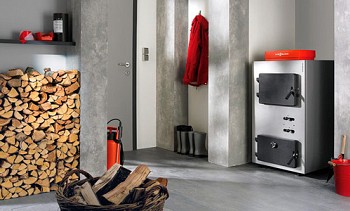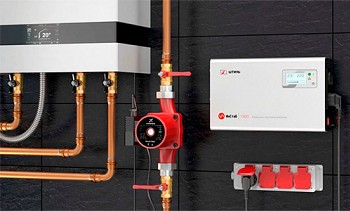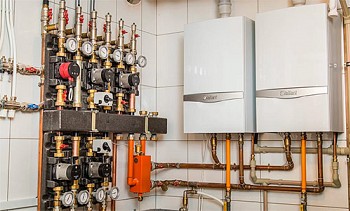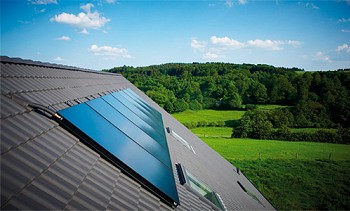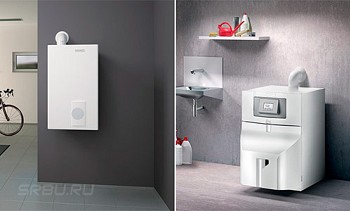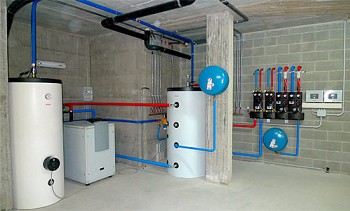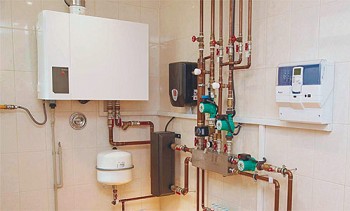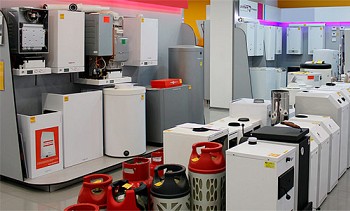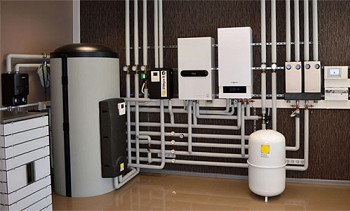Failure to comply with the requirements for installing a gas boiler in a private house is a risk to face a number of serious problems. Such violations with a high degree of probability become the root cause of fire, explosion, carbon monoxide poisoning, incorrect and uneconomical operation of the equipment. Due to inconsistencies, the gas service is guaranteed to refuse to connect and commission the boiler. After reading this material, you can protect yourself from the above troubles.
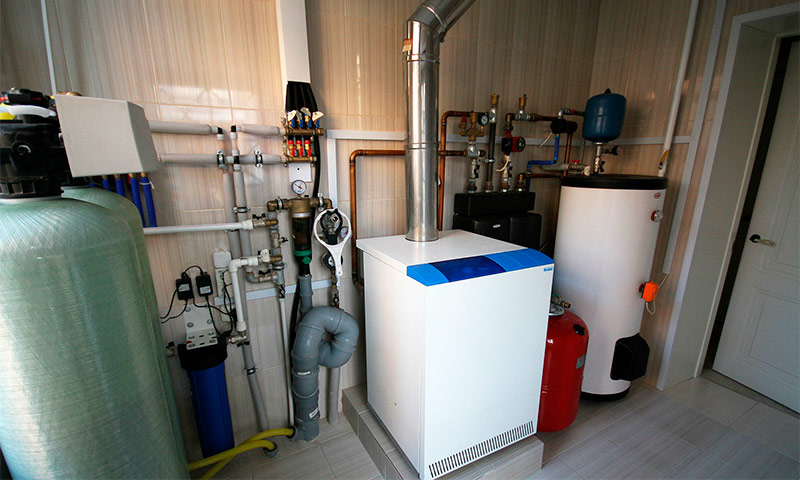
Content:
Regulatory provisions and design documentation
Absolutely all requirements for the installation of gas boilers are freely available in the following building codes:
- SNiP 31-02-2001;
- SNiP 2.04.08-87;
- SNiP 41-01-2003;
- SNiP 21-01-97;
- SNiP 2.04.01-85.
Further, data and figures taken from the corresponding SNiPs are used.
1. You need to start by submitting an application for approval of technical conditions. The presence of this document entitles the applicant to begin installation and connection of heating equipment to the central gas main. The application is executed in the gas service, where it is reviewed by specialists within thirty calendar days.
In order to expedite the receipt of the above document and to avoid possible hiccups, the application must indicate the estimated average daily amount of natural gas, which will be required to meet heating needs. This figure is calculated individually according to the standards given in the first of the listed SNiPs.
- For a domestic gas boiler with a hot water supply and used in central Russia, the fuel consumption is 7-12 m3/day.
- A gas stove for cooking consumes 0.5 m³ / day.
- The use of a flowing gas heater (gas column) consumes 0.5 m³ / day.
For a number of reasons, after consideration by the gas service, an application for a permit for connection may be refused. At the same time, the responsible body is obliged to issue a document to the owner of the private house, which officially indicates all the reasons for the refusal. After their elimination, the application is submitted again.
2. The next step after obtaining the technical conditions is an even longer, but necessary process - the creation of the project. The main part of this document is a plan diagram showing the location of the boiler, metering equipment, gas pipelines, as well as all connection points.
To draw up a project, an appropriate specialist is always involved. He must have permission to do this work. It will not work out on our own. In any case, the gas service will not accept a document prepared by a layman.
After drawing up the project, it must be submitted for approval. This is the responsibility of the gas service department, which controls gas supply in a specific locality or area. As a rule, it takes up to 90 days to agree on a project, and only after receiving a positive response can you begin work on equipping a boiler room and installing a heating unit.
Together with the project and the application for its consideration, the following documents must be attached:
- technical passport (available with equipment);
- official instructions for use (copy possible);
- certificates
- document confirming the compliance of specific equipment with safety requirements.
It is also recommended to consult with the specialist who makes up the project.He will provide the most relevant information on these issues, talk about possible innovations, changes in legislation and common pitfalls. This knowledge is guaranteed to save you a lot of time and nerves.
Coordination of the project, similarly to obtaining technical specifications, may result in failure. At the same time, an instruction is issued to the owner in his hands, which indicates errors, shortcomings or inconsistencies that need to be addressed. After corrections, the application is submitted and reviewed again.
Space requirements for installing a gas boiler
Comprehensive information on the proper preparation of the premises is contained in one of the above documents. Including, there are instructions on the dimensions of the boiler room, the arrangement of the front door, the height of the ceiling and other important parameters (see key requirements below).
It is immediately worth noting that if the maximum thermal power of a gas boiler is more than 30 kW, then a separate room must be allocated for its installation. Models with lower performance and with the appropriate location of the outlet under the chimney can be installed, for example, in the kitchen. It is strictly forbidden to install a gas boiler in the bathroom. You can not install it in the bathroom, as well as in rooms that are considered residential by purpose. Alternatively, it is allowed to equip the boiler room in a separate building. At the same time, their norms are taken into account, about which there is information below.
The boiler room in a private house can be equipped at the basement level, in the attic (not recommended) or simply in a room specially equipped for these tasks.

In accordance with the rules for installing a gas boiler in a private house, it must be equipped taking into account the following criteria:
- Area not less than 4 m2.
- One room is designed for no more than two units of heating equipment.
- Free volume is taken from 15 m3. For models with low performance (up to 30 kW) this figure can be reduced by 2 m2.
- From the floor to the ceiling should be 2.2 m (not less).
- The boiler is installed so that the distance from it to the front door is at least 1 m; It is recommended to equip the unit near the wall, which is located opposite the doorway.
- At least 1.3 m of free space must be left on the front of the boiler for setting, diagnosing and repairing the unit.
- The width of the front door is taken in the region of 0.8 m; it is desirable that it opens outward.
- The room provides a window with a vent that opens outward for emergency ventilation of the room; its area should be no less than 0.5 m2;
- Finishing surfaces must not be made from materials that are prone to overheating or fire.
- A separate power line is introduced into the boiler room to connect the lighting, pump and boiler (if it is volatile) with its own circuit breaker and, if possible, with an RCD.
Particular attention should be paid to the arrangement of the floor. It should have a solid base in the form of a rough screed with reinforcement, as well as a finish coating of completely non-combustible materials (ceramics, stone, concrete). To make the boiler easier to set up, the floors are made strictly according to the level.

On a curved surface, the installation of the boiler may be difficult or impossible due to insufficient overhang of the adjustable legs. It is forbidden to place third-party objects under them in order to level the unit. If the boiler is installed unevenly, it may not work properly, with increased noise and vibration.
To fill the water heating system and its recharge during operation, it is necessary to introduce a cold water supply pipe into the boiler room. To drain the system for the period of maintenance or equipment repair, a sewer point is set up in the room.
To the chimney and ensuring air exchange in the boiler room of a private house, special requirements are made, therefore this issue is considered in a separate subparagraph below.
If the room for the installation of a gas boiler is equipped in a building separate from the private house, then the following requirements are imposed on it:
- own foundation;
- concrete base;
- the presence of forced ventilation;
- doors must open outward;
- boiler room dimensions are calculated according to the above standards;
- no more than two gas boilers are allowed in the same boiler room;
- the presence of a properly equipped chimney;
- it should be freely accessible for cleaning and other operations;
- To supply piece lighting and heating equipment, a separate input with an automatic machine of the corresponding power is provided;
- water supply should be organized so that in the cold season the line does not freeze.

Mini boiler installed near the house.
Floors, walls and ceilings of a separately equipped boiler room must also be made and finished with materials corresponding to the class of non-combustible and heat-resistant.
Chimney and air exchange requirements
The current standards for the installation of gas boilers in private homes provide a number of requirements for the organization of normal air exchange in the boiler room. In particular, one should be guided by the rule that the installed ventilation system must ensure uninterrupted operation to provide three-fold air renewal in the room in one hour.
If the norms of the arrangement of ventilation are neglected, or an insufficiently efficient system is installed, the correct operation of the boiler will be impossible due to a lack of oxygen. An inflow of fresh air is needed to prepare a combustible fuel mixture, and due to its lack, the boiler will not work stably. Moreover, insufficient air exchange will cause accumulation of carbon monoxide in the boiler room, which is deadly to humans!
For example, consider a low-power gas boiler with a nominal heat output of 23 kW. According to manufacturers' instructions, modern models with such a capacity burn about 2-2.5 m in one hour3 gas. In order for this volume to completely burn out, at least 30 m must enter the boiler in the same hour3 fresh air. If it is less, the gas will not be completely burned, which will negatively affect the efficiency of the heating system of a private house. For other modifications, the rate of fresh air flow is usually indicated in the specifications and related documentation for gas equipment.
In the boiler room with a gas boiler, a supply and exhaust ventilation system is always installed, which provides not only fresh air, but also the forced removal of carbon monoxide in the event of a malfunction in the chimney. The supply duct is best equipped on the opposite side of the boiler, near the front door. For maximum efficiency, it should be located as low as possible.

Boiler room ventilation scheme.
The area of the ventilation supply duct is calculated based on where fresh air is taken from. If it comes directly from the street, then the cross section of the channel should be 8 cm2 for each kW of thermal power of the boiler. For example, for a 30 kW boiler, the area of the ventilation duct must be at least 240 cm2 (this is a square with sides approximately 15 cm long). If air intake is carried out from the next room, the cross-section of the supply channel increases to 30 cm2 for each kW of thermal power of the boiler (in our example, this is already 900 cm2, which corresponds to a square with sides of 30 cm). It is for the latter reason that it is recommended to organize an influx of fresh air from the street.
It is recommended to equip the boiler in the immediate vicinity of the chimney. Gas boilers with a closed combustion chamber are equipped with a coaxial chimney. Coaxial chimney consists of two pipes of different diameters, which are inserted one into the second.

Coaxial chimney.
Thus, the boiler can take oxygen from one pipe and remove combustion products through the second. This design feature allows you to operate such boilers without the organization of additional ventilation.
Varieties of coaxial chimney:

Coaxial chimney horizontal type.

Coaxial chimney vertical type.
For boilers with an open combustion chamber, a conventional (traditional) chimney is required. For such boilers, the presence of forced ventilation is mandatory.
The device of a traditional chimney:

There are many ways to equip such a chimney:
















The section of the channel under the chimney should correspond to the diameter of the outlet on the boiler. This value can be found in the technical description of the purchased boiler model. Along with this, it should be borne in mind that for boilers with an open combustion chamber and thermal power up to 30 kW, the diameter must be at least 13 cm, and for a 40-kilowatt - 17 cm.
On the way from the boiler to the wall, the chimney should have as few bends and turns as possible (but no more than 3). It is best if they are not in the room at all. For this, many modern gas boilers provide two outlet openings - one on top, the second on the back.
The chimney pipe must be made of stainless or carbon sheet steel. The use of an asbestos pipe is also allowed, however, from its beginning to the boiler outlet pipe there must be a minimum distance of 50 cm. It is strictly forbidden to connect such a pipe directly to the boiler.
There are also a number of requirements regarding the location of the chimney outside the private house:
- The pipe should rise 0.5 m above the roof without a ridge.
- The pipe facing the ramp at a distance of 1.5 m from the ridge should rise 0.5 m from the ridge.
- If, with a similar configuration, the pipe is removed from the ridge by a distance of 1.5 m to 3 m, then its upper cut should not be lower than the level of the ridge.
- If the pipe goes into a slope farther than 3 meters from the ridge, then its upper cut should be not lower than the conditional line drawn from the top of the roof at an angle of 10 ° relative to the horizon.

Rules for installing gas heating boilers
In accordance with the rules for installing a gas boiler in a private house, the table below shows the distances between the key points within which the heating equipment is positioned.
| Point 1 | Point 2 | Distance, m | Possible consequences of a violation of the rules |
|---|---|---|---|
| Boiler cover | Ceiling | 1,2 | Overheating and fire of the ceiling lining |
| Rear (side) wall of the boiler | Unprotected wall | 0,32 | Overheating of the wall, incorrect operation of the boiler, failure of the electronics |
| Sheet metal protected wall | 0,26 | ||
| The vertical part of the chimney | Unprotected wall | 0,5 | Overheating of wall material, increasing the risk of fire |
| Sheet metal protected wall | 0,25 | ||
| Wall mounted gas boiler | Floor | 1-1,6 | Improper equipment operation, reduced safety |
| Boiler | Entrance door | 1,3 | Inability to open the door, violation of a number of safety rules |
Floor boilers are installed on a pre-prepared rigid and level base. The unit should be located on all regular legs at the same time. At the same time, its position relative to the horizontal and vertical is controlled.
Wall-mounted boilers are by default hung on brackets specially provided for equipment. The use of freelance mounts for these purposes is strongly discouraged. Particular attention should be paid to the reliability and carrying capacity of installed canopies. To fix them on the wall, you need to use dowels with impact screws or anchor bolts of the corresponding diameter and length.
After installing the boiler, all the necessary communications are brought to it - water supply, sewage, heating system branches, power supply (if necessary).

